quantum dot
Latest

Alienware's quantum dot OLED monitor promises color-accurate gaming
Alienware has unveiled a quantum dot OLED monitor that promises both smooth gaming and very high color accuracy.
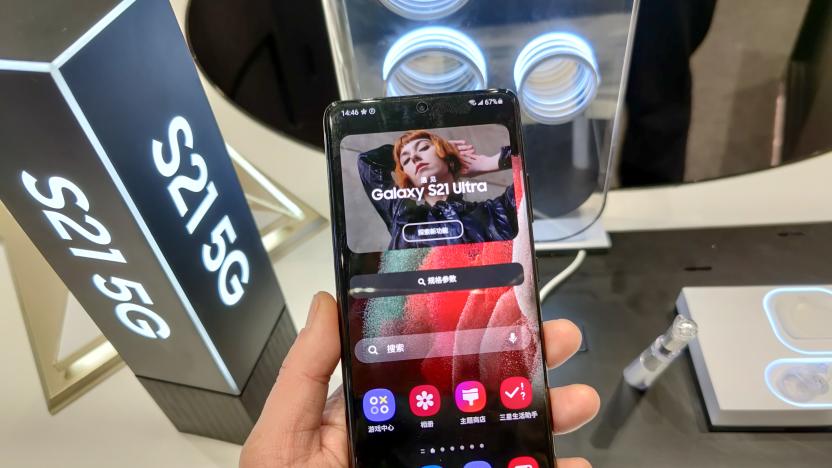
Samsung's profits rose in Q1, but the chip shortage looms over Q2
Samsung's consumer electronics profits hit a new record high for Q1, but the company warned investors that sales will slow in Q2 due to component shortages.
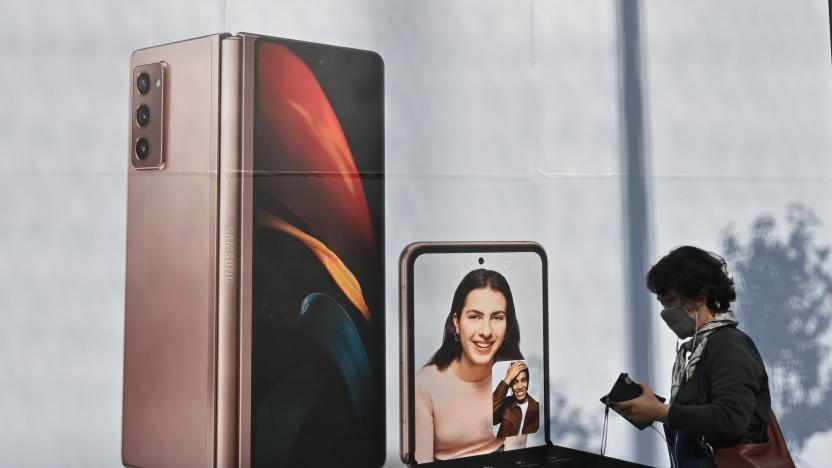
Samsung's mobile sales are up 51 percent over last year's numbers
According to Samsung, despite the pandemic profits in its mobile business are up sharply from the dip it experienced in 2019. Samsung already told investors to expect higher profits for Q3 of 2020, but now the detailed results are out, revealing operating profit in its mobile division that’s up 51 percent over the same period last year (PDF). Samsung also saw growth in its display business (which accounts for screens sold to others, like the OLED displays in Apple’s iPhone 12 lineup), and memory chips, which go in phones, servers and help power the graphics cards for new GPUs and game consoles.
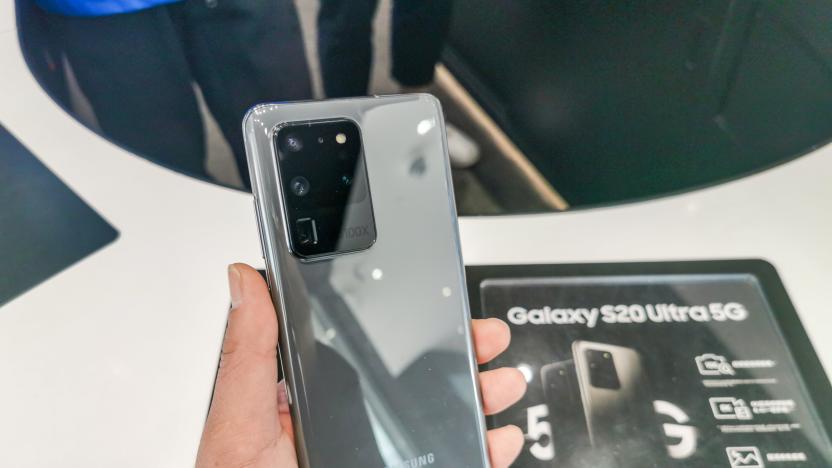
Samsung looks forward to quantum dot TVs, new game systems and phones
Samsung will launch its new Galaxy Note and Galaxy Fold devices next week, but its Q2 earnings rose on higher prices for memory chips and a one-time payment. Later this year it's predicting more growth in the mobile business from 5G, plus more demand for RAM due to new consoles launching.

Samsung's display business will stop producing LCD screens this year
Samsung Display will stop producing liquid crystal display (LCD) panels in China and South Korea at the end of the year in order to concentrate on the new generation of "quantum dot" (QD) screens, Reuters reports. Any LCD orders made before the end of the year will still be fulfilled. Samsung made its plans for QD tech known last year, when it announced its $11 billion investment into a plant capable of manufacturing true QLED TV screens that self-illuminate. Traditionally, Samsung's quantum dot LCD tech puts LED backlights behind a filter (so the display doesn't match up to the likes of say, LG's OLED TVs), but research at the end of 2019 helped mitigate some development problems, such as burn-in. Samsung's forthcoming QD tech instead relies on indium phosphide instead of toxic cadmium, and has a lifetime of up to a million hours. The multi-billion dollar investment will take place over five years and will see Samsung convert one of its existing South Korean LCD lines into a facility to mass produce these screens. Falling demand for LCD products and a manufacturing supply glut means Samsung is obviously looking for new avenues, so for the company to essentially do away with a tried-and-tested technology and go all-in on another suggests that QD screens are very likely to feature in our viewing futures.

Samsung unveils its latest 4K and 8K QLED TVs for the US
Samsung's 4K and 8K TV launch is one of the more controversial in years, because Samsung appears to be saving high-end features for the much more costly 8K models. We first saw signs of it in January at CES 2020, when Samsung failed to show off any mainstream 4K sets, while displaying a plethora of 8K models. The company has now effectively confirmed that situation with the US launch of its new lineup.
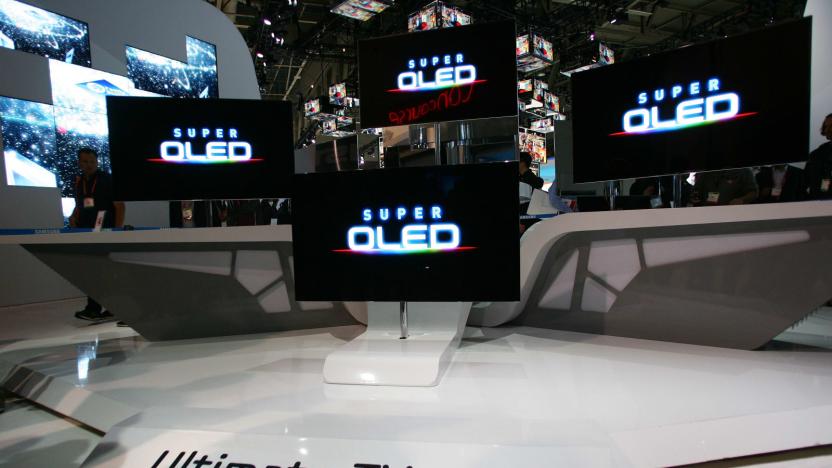
Samsung gets closer to building 'QD-OLED' TVs that rival LG's OLED
While Samsung has become dominant in using OLED technology on mobile displays -- even Apple uses its screens for iPhones -- in TVs, the big name in OLED is its competitor, LG. LG's TVs have wowed testers with their ability to control light precisely because each pixel is self-illuminating, unlike the "QLED" branded quantum dot LCD tech Samsung relies on exclusively, which still puts LED backlights behind a filter. That could change soon, however, as Samsung announced in October that it's investing $11 billion by 2025 to build a plant capable of manufacturing true QLED TV screens that self-illuminate. It tried building TVs with the technology earlier this decade, like the 55-inch Super OLED screens shown above. But it opted out of further development, claiming burn-in is too much of a problem and saying the TVs would have a short lifespan. Now two Samsung researchers, Dr. Eunjoo Jang and Dr. Yu-Ho Won have published a paper in Nature about new quantum dot LED technology that relies on indium phosphide instead of toxic cadmium, and has a lifetime of up to a million hours. Their improved shell design appears to increase efficiency by preventing oxidation and energy leaks. For Samsung to make that big investment in building "QD-OLED" displays it must believe any issues are going to be resolved soon, it's just a matter of when we'll actually see new TVs on shelves.
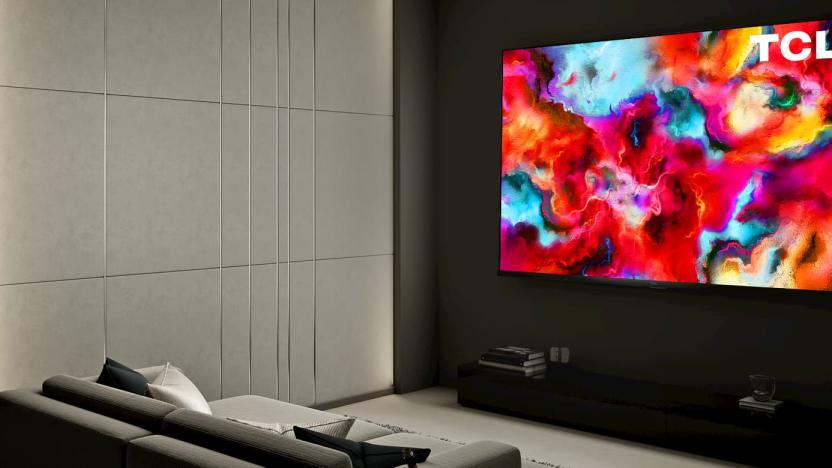
TCL opens up pre-orders for its 8-series 4K QLED TVs
Less than a month after putting its 6-series 4K QLED TVs on sale, TCL is opening up pre-orders for its 8-series displays through Best Buy. The 8-series is a newcomer to the TCL Roku TV range. Like the 6-series, it boasts boast quantum dot LED technology for better color performance, along with support for Dolby Vision, HDR10, HLG (Hybrid Log Gamma) and Dolby Atmos. It works with Google Assistant, Alexa and Roku Voice and comes with a voice remote.

TCL's 2019 quantum dot-enhanced 4K TVs go on sale starting at $599
Over the last few years TCL has developed a reputation for releasing high-quality, low-price 4K TVs, with Roku's smart TV platform built-in as well as support for Dolby Vision HDR and Atmos audio. Its 2018 lineup garnered awards and recommendations from all over, and the 2019 model year TVs are ready to roll out. TCL announced details on its new 6- and 8-series models last month, and now revealed that the mainstream 6-series 4K TVs are on sale. That includes a 55-inch model that starts at $599, which is $50 less than the same size last year, and a 65-inch version that carries over the $799 starting price from 2018.

3M and Nanosys team-up to roll out quantum dot-enhanced LCDs
Nanosys' eye-popping QDEF (Quantum Dot Enhancement Film) might be inching closer to a display near you. A new partnership with 3M aims to get the color-loving tech commercialized and into mainstream products. The film uses quantum dots to create an LCD with a wider color gamut -- apparently translating to up to 50 percent more color. The quantum dots are packed onto this film in their trillions (yes, trillions) which is then fitted within the backlight. As the new layer would replace the existing one within LCDs, Nanosys' solution aims to avoid the need for new equipment or processes. However, we're still waiting for high-color QDEF to become that "ecosystem changer" we were promised.

Aluminum oxide 'egg-carton' could improve quantum dot efficiency
Quantum dots have been deemed the future of everything from light bulbs, to displays and solar panels. Yet, one thing has been keeping them down -- a lack of efficiency. Current has a tendency to leak in between the dots, instead of passing straight through all the time. But, researchers at Harvard have found a possible solution. By surrounding the dots with an insulating layer of aluminum oxide, which hugs them like an egg carton, they were able to direct the current, greatly increasing the light-emission yield and reducing wasted electricity. Of course, this only applies to light-producing quantum dots at the moment, but it's possible it could eventually be applied to solar panels and increase the amount of energy harvested from the sun's rays. If you're scientifically inclined, check out the latest issue of Advanced Materials for the complete research paper.

Nanosys QDEF screen technology ships in Q4, slips into iPad at SID 2011 (video)
We dropped by Nanosys' nook at SID 2011, and not only was it showing off its new Quantum Dot Enhancement Film, but had hacked the tech into an off-the-shelf iPad. A company representative presented the modified slate as an example of how quickly QDEF's high color gamut magic could be integrated into existing devices, offering "OLED color depth without OLED power consumption and OLED price." Sure enough, we were told to expect to see QDEF in a "mobile device," probably an Android tablet, sometime in Q4; when pushed for details, our rep could only tell us that the device would come from a Korean firm. (LG or Samsung, take your pick.) Integrating QDEF into new devices may be a snap, but company representatives told us the film could add as much as 100 microns to a screen's thickness, suggesting that smartphone manufactures aren't too keen on the idea of a thicker display. Still, Nanosys has high hopes for the new film and told us that it expects high-color QDEF to become an "ecosystem changer," as industry-altering as HDTV. The firm even suggested "wide color gamut" apps could be in our near future -- we love our color depth here at Engadget, but somehow it's hard to see Angry Birds: High Color (its suggestion, not ours) taking off. Check out our hands-on after the break. %Gallery-123854%

Nanosys unveils Quantum Dot Enhancement Film for LCDs, promises all kinds of colors
Another day, another step closer to quantum dot reality. Today, Nanosys unveiled its new Quantum Dot Enhancement Film (QDEF), marking the first time that the nanotechnology is available for LCD manufacturers. According to the company, its optical film can deliver up to 60 percent of all colors visible to the human eye, compared with the 20 to 25 percent that most displays offer. To create QDEF, Nanosys' engineers suspended a blend of quantum dots within optical film and applied it to a blue LED, which helped get the nanocrystals excited. Once they started hopping around, the dots emitted high-quality white light and a rich, wide color gamut, without consuming as much power as white LED-based materials. No word yet on when we can expect to see QDEF in consumer displays, but Nanosys claims that the film is "process-ready" and easy for manufacturers to integrate. For now, you can amuse yourselves by comparing the two frogs pictured above and guessing which one is covered in quantum dots. Full PR after the break.

NanoPhotonica develops S-QLED, OLED to develop inferiority complex soon
Ahh, the wonders of OLED -- flexible displays, great viewing angles, and low power consumption. However, the folks at NanoPhotonica have "perfected" a quantum dot display technology called S-QLED that allegedly has superior picture quality, uses 30 percent less power, and costs three-quarters less than its OLED competition. The company is gearing up for mass production and is in talks with several OEMs to start producing S-QLED displays, but unfortunately there's no timetable for when they'll get to market. Guess we'll have to wait a bit longer to see just how perfect these QLEDs really are.

Samsung creates first full-color quantum dot display, threatens to make Dippin' Dots obsolete
We haven't been serving up quantum dots news for quite as long as we've been regaling you with tales of quantum computers, which is just as good because we're about to tell you the technology is still at least three years away from showing up in something you can buy. But, it is getting closer, with Samsung demonstrating a four-inch quantum dot display with full color. Quantum dots are nanocrystals that emit light when they get excited, perhaps on Christmas morning or when waiting for the list of school cancellations on a snowy morn. The size of the crystal dictates the wavelength of light emitted, and by laying precise grids of different sized crystals Samsung creates RGB pixels of the sort needed to make a display. Pixels can be applied directly to glass or to a flexible surface, and in theory they'll be far more efficient than an LCD while brighter and longer-lasting than OLED. Right now, however, they don't achieve any of those benchmarks, which is unfortunately where we circle back to the whole "three years away" thing.

LG and QD Vision unite for QLEDs: the quantum dot displays of our power-efficient future
Seems like LG really has a thing for those quantum dot LEDs. After hooking up with Nanosys earlier this year, the Korean giant is now stretching out another of its tentacles -- LG Display, to be specific -- for a partnership with a competing QLED designer in QD Vision. What's being promised by this joint venture falls right in line with your generic pipe dream -- better color accuracy than OLEDs, up to twice the power efficiency at a given color purity, and a cheap and straightforward manufacturing process. In fact, because QLEDs do not require the same glass substrate as most current display technologies, they offer unmatched flexibility (olé!) in terms of how and where they may be used. The only downer, and you had to know there would be one, is that QD Vision describes its tech as still in the "development stage," but hey, at least we have another cool acronym to add to our library.

Fujitsu's quantum dot laser fires data at 25Gbps, not just for show
Fujitsu just announced what's reportedly the world's first quantum dot laser capable of 25 gigabits per second of data transmission. Go on -- there's no need to hold your applause. Now, we've seen lasers beam packets at 1.2 terabits per second over miles of open ground, and up to 15.5Tbps through a fat optical pipe, so why would a measly 25Gbps attract our attention? Only because we hear that the IEEE is hoping to create a 100Gbps ethernet standard by 2010 (that's now!) and four of Fujitsu's new nanocrystal lasers bundled together just so happen to fulfill that requirement. It also doesn't hurt that the company's quantum dot solution reportedly uses less electricity than the competition, and that Fujitsu has a spin-off firm -- QD Laser -- champing at the bit to commercialize the technology. All in all, this tech seems like it might actually take off... assuming early adopters are more successful than major corporations at deploying the requisite fiber. Either that, or we'll just enjoy some seriously speedy displays and external drives, both of which sound downright delightful in their own right.

InVisage envisions a world where cell phone cameras don't suck, embraces quantum dots
The invention of nanocrystal semiconductors -- more commonly called quantum dots -- has spurred scientists to create everything from precisely-colored LED lamps to higher-density flash memory. There's also been some talk of applying a solution of the tiny crystals to create higher sensitivity cameras, and according to a company named InVisage, that latter utility is almost ready for commercial production. By smearing light-amplifying quantum dots onto the existing CMOS sensors used in cell phone cameras like so much strawberry jam, InVisage claims it will offer smartphone sensors that have four times the performance and twice the dynamic range of existing chips by the end of the year, and roll out the conveyor belts in late 2011, just in time for the contract to end on your terrible new cameraphone. [Thanks, Matt]

Nanosys and LG Innotek agree deal for newfangled LED-backlit displays
For the nitty gritty of how Nanosys' proprietary LED backlighting technology works, check out our earlier coverage here -- what you really need to know is that the company promises a significantly wider color gamut from its displays, while reducing power consumption by up to 50 percent. Quantum dot LEDs have shown their faces before, but now there's the big hulking heft of LG Innotek -- LG's component manufacturing arm -- behind what Nanosys is offering, which indicates we might actually see the release of nanotech-infused displays within the first half of this year as promised. The early focus appears to be on mobile phones, which gives us yet another next-gen feature to add to our list of requirements for our next phone. Check out the full PR after the break.

Quantum dots make for more pleasing LED lamps
Many who grew up beneath a warm, inefficient incandescent or halogen glow are having a hard time coming to grips with the stale, stiff, efficient illumination provided by CFL or LED bulbs. Two companies, Nexxus Lighting and QD Vision, have paired up to change that, with the former providing an 8 watt (75 watt equivalent) LED bulb, and the latter providing a thin film of quantum dots that can precisely control its color. The dots are microscopic particles that filter light into different colors depending on their size, from red to blue as the dots get smaller -- some only 10 atoms in diameter. The first bulbs are due later this year, and while no word on price is given, Nexxus's current LED bulb costs $100 on its own and surely that layer of dots won't come cheap. Also, no word on whether you'll need to use a Handlink to turn the thing on and off.[Via Physorg]










